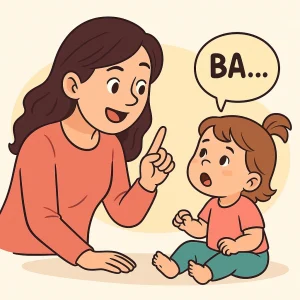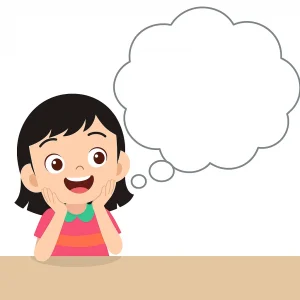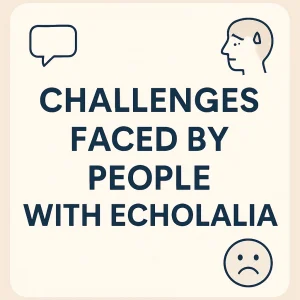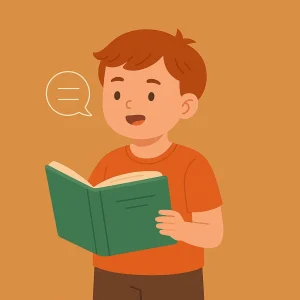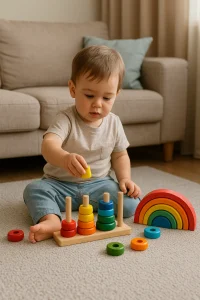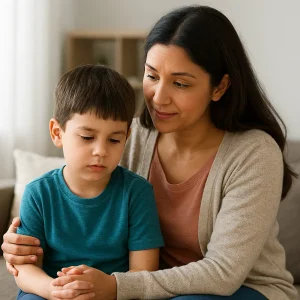My 3-Year-Old Only Uses Gestures – Is It a Speech Delay?
By Rajini D
Last Updated: April 26, 2025
Does your 3-year-old mostly point, wave, or pull your hand — but hardly say any words?
If you’re feeling anxious or wondering, “Is this normal?” you’re not alone. Many parents find themselves stuck between waiting and worrying.
While every child grows at their own pace, recognizing when gestures should turn into words can make all the difference.
The good news? You’re not powerless. With simple daily habits and early support, you can gently help your child find their voice — and today is a perfect time to start.
Speech and Communication Milestones at 2–3 Years
Between ages 2 and 3, your child’s speech and language skills typically start to take off. It’s an exciting phase where little words can turn into big conversations — but we know it can also be stressful if you’re not hearing many words yet.
So, what’s considered typical speech development at this age?
Here’s a quick overview of common milestones most toddlers reach between 24 and 36 months. Remember, these are general guidelines — some kids move a little faster or slower, and that’s okay.
By age 2 to 3, most children can:
- Say 50 or more words
- Put two to three words together in short phrases (like “want juice” or “go park”)
- Understand and follow simple directions (such as “give me the ball”)
- Use gestures like pointing or waving along with speech
- Name familiar objects, animals, or people
- Repeat words they hear — even if not perfectly
- Respond to their name and simple questions like “Where’s your shoe?”
Also Read: Speech Development Milestones: Your Child’s Talking Journey
What Gestures Mean — and When They’re Not Enough
If your 3-year-old mostly points, waves, or pulls your hand instead of talking, you might be wondering — is this still okay at this age?
The short answer is; gestures are a great start. In fact, they’re one of the earliest ways toddlers learn to communicate. Things like pointing to a toy, waving goodbye, or clapping after a song show that your child is socially engaged and understands basic communication — even before words come in.
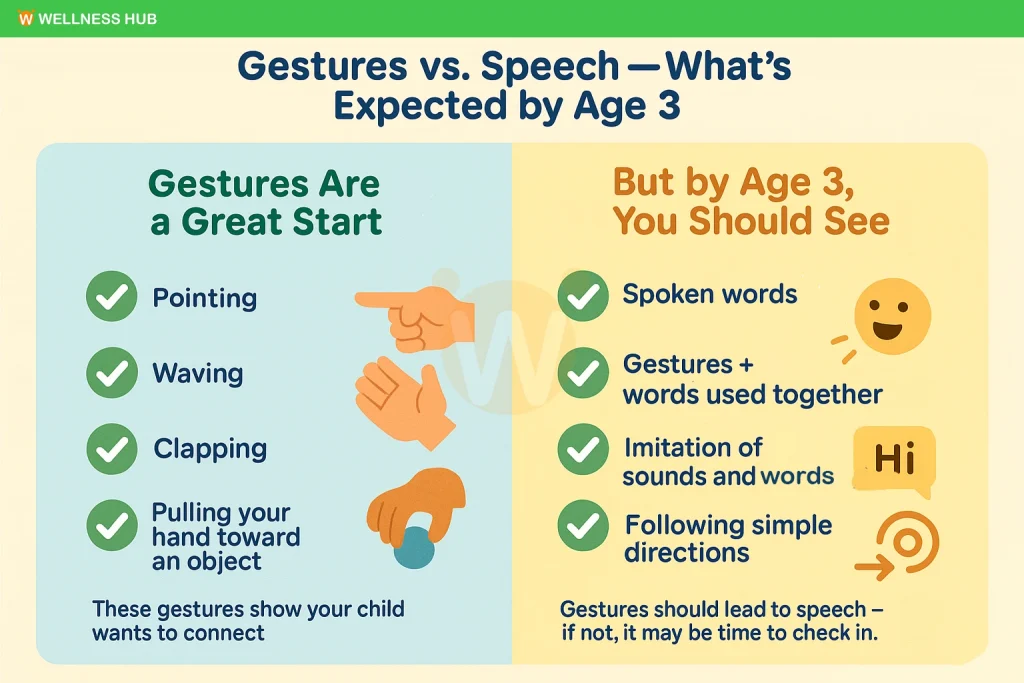
But by the time your child turns 3, gestures should work with words, not replace them. That means you should be seeing spoken words growing alongside those gestures — things like “want ball” while pointing, or “bye-bye” while waving.
If your child is still mostly relying on gestures without adding words, it could be a sign to look a little deeper.
Gestures may signal a speech delay if:
- Your child uses gestures but doesn’t say clear words
- They don’t try to repeat words or sounds
- Gestures are repetitive (e.g., flapping, spinning) or lack clear social purpose
- They don’t combine gestures with speech by age 3
Red Flags That May Indicate a Delay
If your child is 3 years old and not talking yet — or uses mostly gestures instead of words — it’s completely natural to feel concerned. But take a deep breath: you’re not alone, and noticing the signs early is one of the best things you can do.
Every child develops at their own pace, but there are certain red flags that might suggest it’s time to explore speech and language support.
Here are some signs that may point to a speech delay in toddlers:
- No spoken words by age 2.5–3
- Only uses gestures to communicate needs (like pointing or pulling your hand)
- Doesn’t respond to their name or seems uninterested in interactions
- Avoids eye contact or rarely engages with others
- Doesn’t try to imitate sounds, words, or facial expressions
- Difficulty following simple instructions like “come here” or “give me the toy”
- Limited interest in social play or playing pretend
Even if your child shows just one or two of these signs, it’s worth checking in. Sometimes what looks like a phase could be a sign that your child needs a little extra support — and that’s okay.
How You Can Support Speech Development at Home
If your child isn’t using many words yet, don’t worry — you can make a big difference at home. Simple changes in how you talk and play with your toddler can gently encourage speech and boost their confidence.
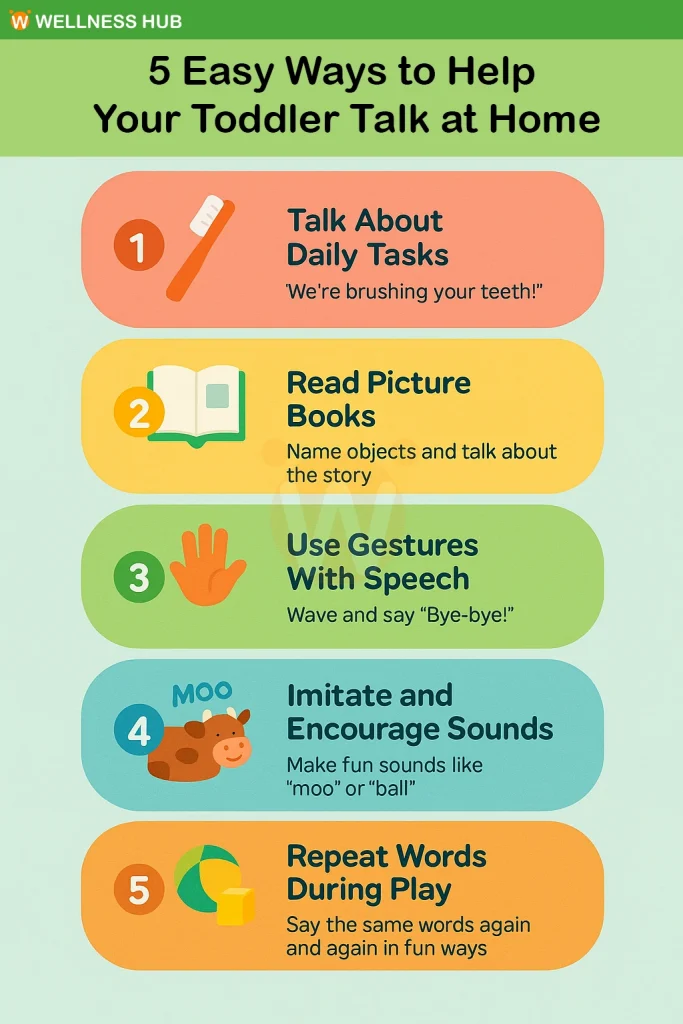
Here are five parent-tested ways to help your child build language — right from your daily routine:
1. Narrate Your Day
Talk out loud about what you’re doing — even if it feels a little silly at first!
- Say this: “I’m cutting the apple. Now I’m putting it in your bowl.”
- This helps your child connect words to actions in real time.
2. Read Books and Label Everything
Choose colorful picture books with clear, simple images.
- Point and name objects: “Look! A dog. The dog says woof!”
- Repeat words often. Repetition helps with memory and understanding.
3. Use Gestures While Speaking Clearly
Gestures can support your child’s understanding — especially when paired with words.
- Wave while saying “bye-bye”
- Point to objects as you name them
This shows your child how gestures and speech work together.
4. Encourage Imitation
Make speech a two-way street by pausing and giving your child space to copy you.
- Play sound games like “moo,” “baa,” or “beep beep”
- Encourage them to copy your words, sounds, or even facial expressions
5. Reinforce Speech During Play
Play is a powerful teaching tool.
- Use pretend food, cars, or dolls and talk through the actions: “The car goes fast!”
- Praise any attempt to speak — even if it’s just babbling. Every effort counts.
| Activity | What It Builds |
|---|---|
| Talking during chores | Vocabulary, attention |
| Reading picture books | Word recognition, memory |
| Sound imitation games | Listening, pronunciation, confidence |
| Pretend play | Storytelling, social interaction skills |
Also Read: 10 Things Your 2-Year-Old Should Be Able to Do
Every Child is Unique — Early Action Builds Confidence
One of the hardest parts of parenting is wondering if your child is “on track.” It’s so easy to compare — especially when other children the same age seem to be speaking more or interacting differently.
But here’s the truth — every child develops in their own way, at their own pace.
Some children are naturally quiet early on and pick up language later. Others might speak a few words and then suddenly start using full sentences. There’s no one-size-fits-all timeline — and that’s okay.
What matters most is noticing when something feels off and trusting your instincts. As a parent, you know your child better than anyone. If you feel like your 3-year-old is using only gestures, not speaking much, or not engaging like other children, it’s perfectly valid to explore your concerns.
And here’s the good news: early action is a strength, not a sign of failure. Reaching out for guidance doesn’t mean something is wrong — it means you’re ready to support your child in the best way possible.
Conclusion
If your 3-year-old still isn’t talking much and mostly uses gestures, don’t worry — you’re not alone. Many parents have the same concern, and the good news is, support is available.
At Wellness Hub, we’re here to help you understand what’s normal, what to watch for, and how to help your child talk. Whether it’s using our free speech delay checklist, trying easy tips at home, or starting online speech therapy — you have options. Our licensed therapists work with Indian families around the world, offering friendly, one-on-one guidance that fits your schedule and culture.
Frequently Asked Questions:
1. Is it normal for a 3-year-old to not talk but use gestures?
It’s common for toddlers to use gestures like pointing or waving before talking. But by age 3, most children should be saying simple words and phrases too. If speech hasn’t started, it could be a sign to check in.
2. When should I worry about my toddler’s speech delay?
If your child is 2.5 to 3 years old and still not saying clear words or combining words and gestures, it may be time to seek help. Early support can make a big difference in language development.
3. What is the difference between a late talker and a speech delay?
Late talkers usually catch up on their own without therapy. But if your child also struggles with understanding, eye contact, or doesn’t imitate speech, it may be a speech delay needing professional help.
4. Can speech delay fix itself without therapy?
Some children improve on their own, especially if they understand well and show social interest. But if there are several red flags, therapy can help your child learn to talk more confidently and clearly.
5. How do I know if my child needs speech therapy?
Watch for signs like no words, no response to name, or no progress in speech after age 2.5. A speech therapist can assess your child and guide you on what steps to take next.
6. What can I do at home to help my 3-year-old talk?
You can talk to your child during daily routines, read picture books together, and use gestures along with simple words. Playing games that involve naming objects or sounds also helps boost speech.
7. How does online speech therapy work for toddlers?
Online therapy happens through live video sessions with a speech therapist. Parents are involved too, so you learn how to help your child between sessions using fun and simple techniques.
8. Are gestures a good sign in toddler communication?
Yes — gestures show that your child wants to communicate. But by age 3, gestures should come with words. If your child is only gesturing and not speaking, it may be a delay.
9. What are common signs of speech delay in 3-year-olds?
Red flags include no clear words, limited eye contact, no response to name, and not following simple directions. These may suggest your child needs a speech evaluation.
10. Where can I get help if I think my child has a speech delay?
You can start by booking a free consultation with a speech therapist at Wellness Hub. They’ll guide you through a simple screening and offer support that fits your child’s needs.
About the Author:
Rajini Darugupally
M.Sc., Speech-Language Pathologist (9+ years of experience)
Rajini is a passionate and dedicated Speech-Language Pathologist with over 9+ years of experience, specializing in both developmental speech and language disorders in children and rehabilitation in adults. Driven by a desire to empower each individual to find their voice, Rajini brings a wealth of experience and a warm, genuine approach to therapy. Currently, at Wellness Hub, she thrives in a team environment that values innovation, compassion, and achieving results for their clients.
Book your Free Consultation Today
Parent/Caregiver Info:
Client’s Details:
* Error Message
